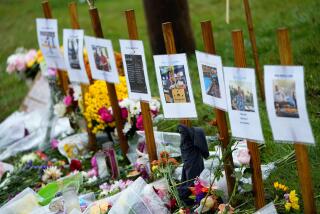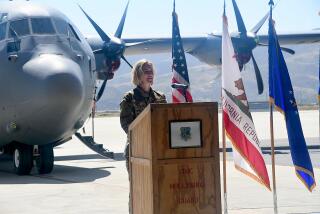Cohen Orders Probe of Alleged Gas Attacks
- Share via
WASHINGTON — Defense Secretary William S. Cohen on Monday ordered an investigation into allegations that a Special Forces commando unit violated U.S. policy and international norms by using nerve gas to kill American defectors and North Vietnamese during a secret 1970 raid into Laos.
Cohen asked the secretaries of the Army and Air Force to look into a CNN-Time magazine account asserting that poison gas attacks during the three-day raid may have killed as many as 20 American defectors and dozens of North Vietnamese troops and civilians.
“I think we need an inquiry,” Cohen told CNN.
But he asserted that he is “not aware of any information” to bear out claims of a nerve gas attack.
If true, the allegations would be a major embarrassment to the United States and could hurt U.S. efforts to renew international sanctions against Iraqi dictator Saddam Hussein because of his suspected arsenal of chemical and biological weapons, said analyst Michael O’Hanlon of the Brookings Institution. The United States has argued that Hussein deserves especially harsh treatment because he has used chemical weapons against his foes.
During the Vietnam War, the United States had a policy of not using chemical weapons on a first-strike basis, though it had not yet signed an international protocol banning the weapons.
The CNN-Time account focuses on several hundred Army commandos who waged war behind enemy lines as members of a unit called the Studies and Observations Group. The group worked with Vietnamese soldiers and its principal objective was observing and disrupting the Ho Chi Minh Trail supply line, which brought men and materiel to the south.
The article quotes Robert Van Buskirk, then an Army lieutenant, describing a mission called Operation Tailwind, in which the commandos attacked a village with nerve gas, then used it again against a contingent of North Vietnamese troops when they blocked the group’s withdrawal.
A commando quoted in the article said that a gas the Army was describing as a form of tear gas was, in fact, the deadly nerve gas sarin, which can kill if it is inhaled or comes in contact with the skin.
*
The report quotes retired Adm. Thomas Moorer, who was then chairman of the Joint Chiefs of Staff, and unidentified senior military officials, as confirming that sarin was used in Operation Tailwind and other operations to remove downed U.S. airmen.
In an interview with The Times Monday, however, Moorer backed away from the CNN-Time report. He said he had no firsthand knowledge that the gas was used anywhere in Southeast Asia. “I’ve never seen a document indicating that it had been used or a document indicating it was going to be used,” he said.
Moorer said that, as chairman of the Joint Chiefs of Staff, he would not have known if chemicals were used in Laos since operations in that country were considered intelligence-related and were under the purview of CIA officials. He said that any decision to use a weapon like poison gas would have been made at an even higher level in the chain of command than the joint chiefs by the civilian leadership of the Nixon administration.
Yet, he said, he found Van Buskirk’s claims believable after hearing what the soldier had said. “He was there and I wasn’t,” Moorer said, adding that he believed use of sarin would be justified to protect American lives.
*
Henry A. Kissinger, then President Nixon’s national security advisor, was said to be traveling abroad Monday and unavailable for comment.
Pentagon officials disputed that there was sarin gas present anywhere in the Vietnam region at the time. They said the chemical had been stored earlier in the conflict at Okinawa but that by 1970 it had been moved to the Army’s chemical stockpile at Johnson Atoll near Hawaii.
They also disputed claims that the 1970 mission had been intended to kill defectors. The operation was undertaken to gather intelligence and destroy supplies and arms, they said, and it led to the destruction of thousands of 120-millimeter and 140-millimeter rockets.
John L. Plaster, who served three tours in Vietnam as a commando and has written a book about his experience, said that he greeted the commandos on their return from Operation Tailwind yet heard nothing about nerve gas attacks.
“I had a beer with these guys when they came back. . . . I didn’t hear anything about it,” said Plaster, long retired from the military.
Gen. William C. Westmoreland, retired commander of U.S. forces in the region, told The Times that he had “no recollection” of the use of nerve gas.
“To me, it’s totally illogical from a practical standpoint,” Westmoreland said. “We used some [tear] gas for some operations to overcome the enemy resistance but not sarin nerve gas.”
Professor Richard Schultz of the Fletcher School of Law and Diplomacy at Tufts University said that he knew nothing of the use of poison gas by the Studies and Observation Group. Schultz, who also is writing a book on the operation, said that he had interviewed four of the five commanders of the unit and read 4,000 pages of declassified documents about its operations.
By 1970, Schultz said, American commanders were especially leery of using any weapons that would expose them to the wrath of American dissidents or foreign governments.
He said that Gen. Creighton Abrams, Westmoreland’s successor, at one point turned down a request from troops to spray North Vietnamese rice with chemicals that would make it taste bad for fear the world would disapprove.
More to Read
Sign up for Essential California
The most important California stories and recommendations in your inbox every morning.
You may occasionally receive promotional content from the Los Angeles Times.











